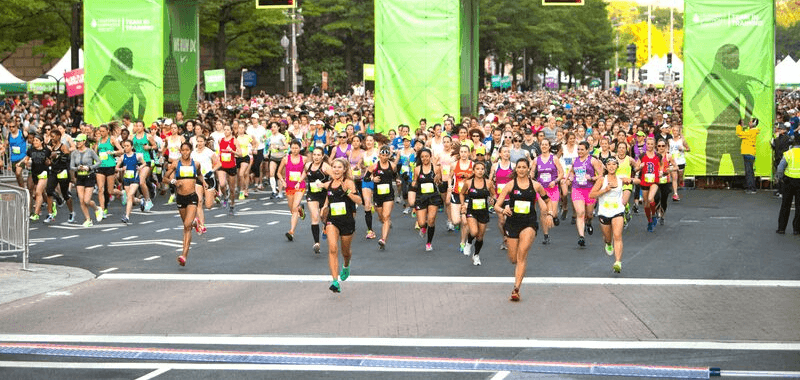Tabla de contenido
A common mistake we make both when we start running and when we have been training for a while is to run at too fast a pace all the time. This is also frequent when we train with people who have been running longer than us and are used to training at a faster pace.
Going at a faster pace is often not good for our bodies and, contrary to popular belief, will not help us reach our goals sooner in the long run. It turns out that slow running has excellent benefits for us because slow running will make you faster in the long run: not only will it allow you to recover, but it will also sharpen your efficiency and avoid injuries that force you to stop.
What is considered slow running?
There is no one way to run. Slow running is something that runners don’t often consider, to the point of dismissing it completely, ignoring all the benefits of its practice. Slow running is also known as “Social Walking,” jogging, recovery, or leisurely paced walking, and is used for active breaks and as a regenerative activity. Many of our training plans include slow-running days.
Benefits of slow-running
The first thing you should know is that by running slowly you start working on your purely aerobic zone before you start generating lactic acid, thus teaching your body to learn to be efficient and oxygenate itself better.
Running slow will help you, in principle, to recover better, improve your running efficiency, and avoid injuries. Other significant benefits are:
- As the body adapts to slower runs, we favor burning fat more efficiently; this is known as the fat-adaptation effect.
- Improve how you control your breathing, favoring the oxygenation of the whole body, including the muscles, and especially the oxygenation of the blood by improving blood flow.
- You will help the heart improve its performance and endurance, so in the long run, you will be able to run longer, no matter the speed, and you will feel less tired.
- By running slowly, you can run with less effort on faster running days. In this way, you can train slow twitch muscle fibers, which as Planet Triathlon points out, allow you to work aerobically on your running to maintain your pace over longer distances.
- Another benefit is that you will reduce the possibility of suffering injuries because you will not subject your body to excessive effort, so you will be able to recover better between one exercise session and another.
- You will allow your body to adapt in order to build a base that will allow you to move on to the next level.
Fatigue and lack of energy that would cause you to give up can set in if you want to start too fast in a short amount of time. So listen to your body and start slow for the best results. Forget about the clock and the abilities or pace of others and remember that running at too fast a pace and running too fast can be somewhat counterproductive to you and the goals you have set for yourself.
One of the most frequently asked questions in our personalized running.COACH plans are: why should I run some lengths so slowly, and, more importantly, how am I going to run so slowly?
Looking for a plan that trains with you, not against you?
At running.COACH, we don’t just build a schedule. We create a smart, living plan that evolves with you. It understands your level, your race goals and your real life. Whether you sync your GPS watch or train straight from our iOS or Android app, your plan adjusts automatically as you improve.
From day one, you’ll feel the difference:
- A fully personalized, dynamic plan designed for you.
- Automatic sync and effortless workout tracking.
- Real-time updates when life happens, including missed sessions, new races or schedule changes.
- Simple, science-backed guidance to train smarter and recover faster.
🎁 Start today and enjoy your first 30 days free.
Because the best training plan isn’t one you follow. It’s one that follows you.app.
Why should I slow running to improve my running?
By running slowly, slowly or gently, or doing recovery runs at a slower pace, you will not only be training your cardiovascular, respiratory, and muscular systems, helping them function more efficiently. It will also help you run better on fast-running days and train your slow-twitch muscle fibers. Always keep in mind what your running goal is when you go out to train. It’s not always about the clock or how fast others are going.
How do you learn to run slowly?
There are different techniques for running slower, slower, or smoother. One is to slow down the cadence of our steps, learn to monitor the movement of our arms, and step with the middle part of the foot.
Here are the answers to these questions
Slow running for beginners to running
If you have been a sedentary person, keeping a slow pace will help you eliminate fat and burn calories. In addition, a slow jog will allow you to build aerobic endurance, which will promote blood circulation, reduce high blood pressure, and control chronic diseases such as diabetes.
Therefore, slow running is ideal not only for those who do it for a particular health situation but also for those who start sports training with a specific goal in mind.
During the first 4 to 6 weeks, when you start running, it is very important to plan your training sessions gently so that you can develop your aerobic base, which will help you make the rest of the work as efficient as possible. That includes adding a fast session, another long run at a slow pace, and two or three shorter and slower sessions during those weeks.
In this sense, intensity is a fundamental factor when following a training plan, and starting with slow running has many benefits. One of them is that it allows you to condition your body by training in what is known as the aerobic zone, in which the muscles work in the presence of oxygen while the body works at a low intensity.
While you, as a runner, perceive that you are exercising in a moderate, smooth, and straightforward manner, oxygen is present when the muscles perform their contractile function. You know you are running slow when you can carry on a conversation with another person without panting, as the oxygen you have is sufficient to do so.
On the other hand, when we start training progressively, we teach our body to work in that aerobic zone before moving to the anaerobic zone, i.e., we enlist it to start working at a higher speed, and lactic acid concentrations start to increase. That’s when the body needs to be able to eliminate it in some way so that the muscles can continue to maintain contractions.
A paper by Runners Connect found that research conducted on untrained or sedentary people suggests that doing a lot of training near the lactate threshold is a very effective way to improve cardiovascular fitness. In contrast, observational studies of elite athletes in a range of endurance sports have found that they tend to spend most of their time training at slower, easier paces.
Slow running for experienced runners
The first thing you should know is that when you alternate your training sessions, you will make progress and improve your endurance capacity. Running slowly will help you recover better, which will ultimately make you run faster in the long run.
Slow and long runs are very important for a marathon runner’s training. Some of the body functions are best trained on long runs with low intensity, such as the fat-burning capacity that is used on long runs.
It is very important to vary intensities between workouts. Each workout has its own purpose:
- Long runs or runs prepare the body for longer distances.
- Steady runs strengthen our fundamentals or capabilities.
- Recovery runs to actively recover.
- Intense runs to increase speed level.
- Steady and recovery runs should be slow.
Slow, easy, or smooth running vs. intensity.
Slow running has to do with training intensity, an aspect that, as the Runners Connect, research points out, has been a hot point of discussion among runners, coaches, and experts and, therefore, complex for science to investigate.
However, a study published in 2007 by researchers from several universities around the world assigned two different training programs to a group of high-level Spanish long-distance runners and followed them for five months to evaluate the issue of exercise intensity.
The length of the study is quite impressive, as is the running ability of the subjects: the twenty men who enrolled in the study had 10K personal bests between 30:30 and 35:00. These men were divided into two groups, each of which was assigned a training program.
The first group was assigned a low-intensity training plan, with 80% of all training performed “easy”: significantly slower than the lactate threshold. The other 20% was equally divided between moderate-intensity (near lactate threshold) and high-intensity (near maximum heart rate) workouts. The second group received a higher-intensity plan, with 65% easy training, 25% moderate intensity, and 10% high intensity.
Individual workouts varied from week to week but were always limited to the same intensity distribution, and the pace was monitored with heart rate monitors. Mileage was accumulated in a typical fashion, with both groups averaging 50-55 miles per week for most of the study.
To ensure that the overall training load was similar for both groups, the researchers used a training load measurement system that took into account both volume and intensity. The authors also set very strict rules about inclusion to ensure that the study protocols were followed.
The study found that although the low-intensity group spent less time training at race-relevant speeds, they improved more than the high-intensity training group.
The central message of this study is to strike a balance between high-intensity training and easier running. If your goal is to go faster, don’t make all your runs faster. First, make sure you are doing enough easy runs to support your ability to do faster workouts.
As always, be careful when increasing training volume. Other research has found that higher mileage is associated with an increased risk of injury and faster times.
Slow or easy running techniques
Decrease your cadence, but not too much.
Cadence is the number of “steps” we take in a minute. It is logical to think that when we change our running pace, our cadence will also change. In English, it is called strides per minute or rpm.
Coach Jack Daniells considers the optimal cadence to be 180 steps per minute. You can measure your cadence through smart watches or heart rate monitors.
The “trick” to maintaining good running form while slowing down is to make sure your cadence doesn’t drop too much. Runners are advised to stay between 2-4% of their regular or marathon pace cadence.
That doesn’t mean you should try to lower your cadence if you don’t feel you need to. However, it does mean that you should increase it if it falls below 2-4% of your standard.
For example, if your normal marathon cadence is 170, you should avoid going below 164 when you try to run slow on your recovery days.
How to do this? By taking shorter strides. A common mistake runners make when running slower is that they want to maintain their stride length.
Monitor your arm movements
Runners often neglect to swing their arms while running, and this can have a big influence on running form. It is impossible to try to make your arms, for example, move slower than your legs or vice versa, which shows that everything is in constant synchrony.
Therefore, if your arms tend to swing from side to side of your hips and your lower body can follow suit, these slight imbalances over time require attention and can lead to injury later in the race.
Swinging your arms can help produce a propulsive force, so the more you swing your arms back and forth, the more your legs will want to follow the same path. Each runner will have an individual degree of arm swing.
The recommended thing to do is visualize your arm motion when you run as if you are trying to brush your pockets or your hips with your thumbs when you are trying to slow down. This way, you will prevent your arms from swinging too far forward or backward as they have a greater distance to travel.
Another way to reduce the side-to-side movement of your arms is to imagine a line that divides your body lengthwise into two halves and make sure that your arms never pass this middle section of your body to the other side.
Try to land on the midfoot
It is not generally recommended that runners concentrate on hip flexion. Hip extension is the distance your leg travels during the push-off. As you pull your leg back, tension is created in the hip flexor muscle, which, like a rubber band, releases stored energy in the hip flexor during the transition to swing passes. When running at a slow pace, it is difficult to achieve that hip extension, as you don’t need to produce much power, so you can’t tap into the stretch reflex.
Expert advice is to focus more actively on driving your leg forward when running slowly, lifting your knees with the principles of proper techniques. Also, it is advised to focus on landing with the midfoot, as for many runners, this generates proper hip flexion. It is almost impossible to land this way without lifting the leg again to get a sense that you are running. This promotes your natural midfoot strength. However, it is important to be cautious about this if you have previous running injuries.
In summary, by running slow or making recovery runs at a slower pace, you will not only be training your cardiovascular, respiratory, and muscular systems, helping them function more efficiently, but it will also help you run better on fast-running days and train your slow-twitch muscle fibers. Always keep in mind what your running goal is when you go out to train; it’s not always about the clock or how fast everyone else is going.
Looking for a plan that trains with you, not against you?
At running.COACH, we don’t just build a schedule. We create a smart, living plan that evolves with you. It understands your level, your race goals and your real life. Whether you sync your GPS watch or train straight from our iOS or Android app, your plan adjusts automatically as you improve.
From day one, you’ll feel the difference:
- A fully personalized, dynamic plan designed for you.
- Automatic sync and effortless workout tracking.
- Real-time updates when life happens, including missed sessions, new races or schedule changes.
- Simple, science-backed guidance to train smarter and recover faster.
🎁 Start today and enjoy your first 30 days free.
Because the best training plan isn’t one you follow. It’s one that follows you.app.











0 Comments